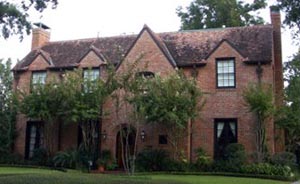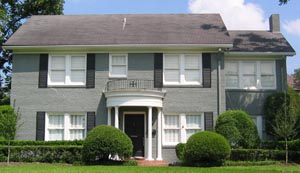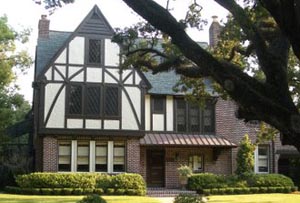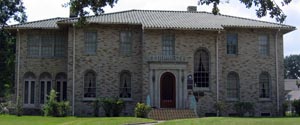




Boulevard Oaks
History and Culture
Boulevard Oaks was designated as an historic district in 2009. The designation was based on the significant architects and builders who created the houses; the public landscaping of North and South Boulevard; the variety of house styles on the boulevards; and the maintenance of the neighborhood since it was built.
Architects and Builders in Boulevard Oaks
- Joseph W. Northrop, Jr., is best known for his Colonial Revival houses. Northrop came to Houston in 1911 with the firm of Cram, Goodhue, and Ferguson to work on the Rice Institute campus. He soon went into independent practice. Northrop was one of the first architects commissioned to develop houses for River Oaks. George Howard, who developed Ormond Place, commissioned most of the houses that Northrop designed in Boulevard Oaks. Northrop designed Colonial Revival houses at 1702, 1715, 1749, 1813, 1817, 1821, 1930, and 1932 South Boulevard. He also designed Howard’s own home at 1707 South Boulevard. Northrop may have also designed 1754 North Boulevard. Northrop’s sole non-Colonial design is at 1617 South Boulevard, a picturesque Tudor home built for attorney R. C. Campbell.
- The Russell Brown Company also contributed to the character of the neighborhood. The company designed and built many houses in this part of Houston between 1902 and 1940. In Boulevard Oaks, it was responsible for the homes at 1611, 1612, and 1636 South Boulevard and 1611 and 1908 North Boulevard. Brown built 1927 North Boulevard for his daughter, Virginia Brown Angly, in 1938.
- Katharine B. Mott and her husband Harry L. Mott built the houses at 1635, 1659, and 1660 South Boulevard. The Motts moved to Houston from Indianapolis in 1928. Mrs. Mott had begun to design houses for her family in the early 1920s. Mr. Mott, a realtor and developer, recognized his wife’s talent. He commissioned her to design houses in one of his Indianapolis developments. Because she had no formal training in architecture, Mrs. Mott worked with Edward James of the Indianapolis architecture firm Burns & James. That firm’s work was usually in the Colonial Revival style, but Mrs. Mott favored rustic French and English designs. Between 1928 and 1932, the Motts built more than 20 houses in Riverside Terrace, Edgemont, Devonshire Place, and River Oaks. Mrs. Mott’s carpenter and brick mason also moved to Houston from Indianapolis. They were both skilled craftsmen. Unique brickwork is a recognizable feature of the Mott houses.
- Joseph Finger was an Austrian immigrant who began practicing architecture in Houston in 1911. He is best known for large public buildings, including Houston’s City Hall. Many of those buildings were built in the Art Deco and streamlined Modernistic styles. Finger was Houston’s premier Jewish architect from the 1910s through the 1940s. He designed many Jewish institutional buildings. Finger also designed large houses in Riverside Terrace and River Oaks. In Boulevard Oaks, he designed the Echols House at 1753 North Boulevard and the Minchen House at 1740 South Boulevard. The Minchen House is the district’s only individually-designated City Protected Landmark.
- Hiram A. Salisbury and Thomas G. McHale were architects from Omaha, Nebraska. They met after moving to Houston, where they worked together. They started their own firm in 1927. Salisbury and McHale designed residential, commercial, and church buildings. They were responsible for many fine houses in River Oaks, Southampton Place, and Broadacres. The homes they designed in Boulevard Oaks include 1519 South Boulevard and 1659 and 1705 North Boulevard.
- William Ward Watkin was the founder and head of the architecture school at Rice University. Watkin designed the Rice campus and other prominent buildings in Houston, including The Museum of Fine Arts. He also laid out the subdivisions of Broadacres and Southampton. Watkin designed the home at 1615 North Boulevard.
- Birdsall P. Briscoe was one of the best and most well-known residential architects in Houston in the 1920s and 1930s. Briscoe may have designed the Maclay House at 1511 North Boulevard. He also designed two houses for sites in Edgemont that were never built. He made changes to the Anderson House at 1659 South, and altered 1729 North for W. S. Bellows. Briscoe’s partner, Sam H. Dixon, Jr., designed the Jack Lander House at 1714 South Boulevard.
- Other architects and builders in the neighborhood included architect Cameron Fairchild (1619 North Boulevard); designer/builder L. W. Lindsay (1645 North and 1512 South); and Hayes & Orem Builders (1716, 1720, and 1728 North Boulevard).